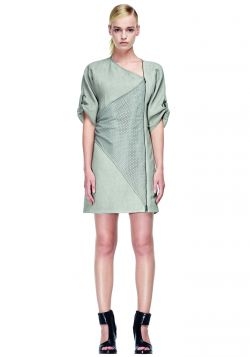PFW: Hussein Chalayan & Kadri Soygül on VSP Chalayan Spring/Summer 2015

The art of collaboration – ‘if it feels right I’ll do it’
The pair came together for this project eight years after they first worked together (Hussein Chalayan used to produce his own line’s leather pieces with the Franco-Turkish brand): « I knew we could be interesting for each other, » explained Soygül, « I know he loves leather and he loves mixing materials. »
Collaborations are certainly buzzing at the moment: It’s been a year in which Chalayan has also worked on a ‘demi-couture’ line with Goga Ashkenazi’s Vionnet, but that doesn’t mean the designer is picking them willy-nilly: « I’m not dying to do many collaborations, it’s just if it feels right I’ll do it, » he explains.
So were there any surprises when the pair sat down to work? Chalayan says he was impressed by the young, dynamic team that VSP had built in the emerging cosmopolis of Istanbul. « There’s something about the Turkish youth that I find very refreshing, » he explains. It plays into some of the designer’s own frustrations with some of the main fashion cities: “I’m bored of people that take themselves too seriously, » he added, going on to contrast the vibe in Istanbul with the scene in London and Paris.
‘New things, and hybrids and things coexisting’
For Soygül, who was raised in Istanbul (where he attended the French lycée), there was a certain synergy when it came to language, and what he put down as « a kind of feeling » shared between him and Chalayan (a Turkish Cypriot who grew up in the UK).
However, the Turkish influence didn’t play out « in terms of design or looking at shapes, » said Chalayan. The London designer instead insists on a sort of cosmopolitan notion of creativity: « understanding of design or culture or aesthetics is a culture in itself. It’s a common language, » he explains.
That said, the clash of old Empires, of multiethnicity, of Turkish, Austrian and Balkan identities in Istanbul helps create that common language, something Chalayan calls « new things, and hybrids and things coexisting. » The sense of openness was expressed in the clothes (like the shape-changing zippers that mean pieces can be worn tight to the body or opened up for a slouchier feel).
Soygül certainly agrees, labeling his young compatriots as « very universal looking people. » This blend of « Occidental, European, North, South and Mediterranean culture » is what excites him for the future — « all these things are mixed up in Istanbul and are flourishing, » he explains.
Regardless of influences, we like what the two designers have dreamed up!

